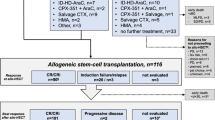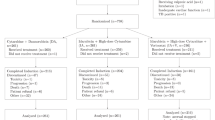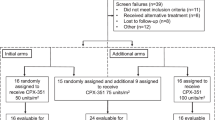Abstract
DNA methyltransferase inhibitors sensitize leukemia cells to chemotherapeutics. We therefore conducted a phase 1/2 study of mitoxantrone, etoposide and cytarabine following ‘priming’ with 5–10 days of decitabine (dec/MEC) in 52 adults (median age 55 (range: 19–72) years) with relapsed/refractory acute myeloid leukemia (AML) or other high-grade myeloid neoplasms. During dose escalation in cohorts of 6–12 patients, all dose levels were well tolerated. As response rates appeared similar with 7 and 10 days of decitabine, a 7-day course was defined as the recommended phase 2 dose (RP2D). Among 46 patients treated at/above the RP2D, 10 (22%) achieved a complete remission (CR), 8 without measurable residual disease; five additional patients achieved CR with incomplete platelet recovery, for an overall response rate of 33%. Seven patients (15%) died within 28 days of treatment initiation. Infection/neutropenic fever, nausea and mucositis were the most common adverse events. While the CR rate compared favorably to a matched historic control population (observed/expected CR ratio=1.77), CR rate and survival were similar to two contemporary salvage regimens used at our institution (G-CLAC (granulocyte colony-stimulating factor (G-CSF); clofarabine; cytarabine) and G-CLAM (G-CSF; cladribine; cytarabine; mitoxantrone)). Thus, while meeting the prespecified efficacy goal, we found no evidence that dec/MEC is substantially better than other cytarabine-based regimens currently used for relapsed/refractory AML.
This is a preview of subscription content, access via your institution
Access options
Subscribe to this journal
Receive 12 print issues and online access
$259.00 per year
only $21.58 per issue
Buy this article
- Purchase on Springer Link
- Instant access to full article PDF
Prices may be subject to local taxes which are calculated during checkout


Similar content being viewed by others
References
Ferrara F, Schiffer CA . Acute myeloid leukaemia in adults. Lancet 2013; 381: 484–495.
Döhner H, Weisdorf DJ, Bloomfield CD . Acute myeloid leukemia. N Engl J Med 2015; 373: 1136–1152.
Amadori S, Arcese W, Isacchi G, Meloni G, Petti MC, Monarca B et al. Mitoxantrone, etoposide, and intermediate-dose cytarabine: an effective and tolerable regimen for the treatment of refractory acute myeloid leukemia. J Clin Oncol 1991; 9: 1210–1214.
Leopold LH, Willemze R . The treatment of acute myeloid leukemia in first relapse: a comprehensive review of the literature. Leuk Lymphoma 2002; 43: 1715–1727.
Ravandi F . Relapsed acute myeloid leukemia: why is there no standard of care? Best Pract Res Clin Haematol 2013; 26: 253–259.
Thol F, Schlenk RF, Heuser M, Ganser A . How I treat refractory and early relapsed acute myeloid leukemia. Blood 2015; 126: 319–327.
Shih AH, Abdel-Wahab O, Patel JP, Levine RL . The role of mutations in epigenetic regulators in myeloid malignancies. Nat Rev Cancer 2012; 12: 599–612.
Abdel-Wahab O, Levine RL . Mutations in epigenetic modifiers in the pathogenesis and therapy of acute myeloid leukemia. Blood 2013; 121: 3563–3572.
Estey EH . Epigenetics in clinical practice: the examples of azacitidine and decitabine in myelodysplasia and acute myeloid leukemia. Leukemia 2013; 27: 1803–1812.
Roboz GJ . Epigenetic targeting and personalized approaches for AML. Hematol Am Soc Hematol Educ Program 2014; 2014: 44–51.
Wouters BJ, Delwel R . Epigenetics and approaches to targeted epigenetic therapy in acute myeloid leukemia. Blood 2016; 127: 42–52.
Qin T, Youssef EM, Jelinek J, Chen R, Yang AS, Garcia-Manero G et al. Effect of cytarabine and decitabine in combination in human leukemic cell lines. Clin Cancer Res 2007; 13: 4225–4232.
Hollenbach PW, Nguyen AN, Brady H, Williams M, Ning Y, Richard N et al. A comparison of azacitidine and decitabine activities in acute myeloid leukemia cell lines. PLoS ONE 2010; 5: e9001.
Kurimoto M, Matsuoka H, Hanaoka N, Uneda S, Murayama T, Sonoki T et al. Pretreatment of leukemic cells with low-dose decitabine markedly enhances the cytotoxicity of gemtuzumab ozogamicin. Leukemia 2013; 27: 233–235.
Leonard SM, Perry T, Woodman CB, Kearns P . Sequential treatment with cytarabine and decitabine has an increased anti-leukemia effect compared to cytarabine alone in xenograft models of childhood acute myeloid leukemia. PLoS ONE 2014; 9: e87475.
Scandura JM, Roboz GJ, Moh M, Morawa E, Brenet F, Bose JR et al. Phase 1 study of epigenetic priming with decitabine prior to standard induction chemotherapy for patients with AML. Blood 2011; 118: 1472–1480.
Song LX, Xu L, Li X, Chang CK, Zhang Y, Wu LY et al. Clinical outcome of treatment with a combined regimen of decitabine and aclacinomycin/cytarabine for patients with refractory acute myeloid leukemia. Ann Hematol 2012; 91: 1879–1886.
Cheson BD, Bennett JM, Kopecky KJ, Büchner T, Willman CL, Estey EH et al. Revised recommendations of the International Working Group for Diagnosis, Standardization of Response Criteria, Treatment Outcomes, and Reporting Standards for Therapeutic Trials in Acute Myeloid Leukemia. J Clin Oncol 2003; 21: 4642–4649.
Walter RB, Othus M, Borthakur G, Ravandi F, Cortes JE, Pierce SA et al. Prediction of early death after induction therapy for newly diagnosed acute myeloid leukemia with pretreatment risk scores: a novel paradigm for treatment assignment. J Clin Oncol 2011; 29: 4417–4423.
Grimwade D, Hills RK, Moorman AV, Walker H, Chatters S, Goldstone AH et al. Refinement of cytogenetic classification in acute myeloid leukemia: determination of prognostic significance of rare recurring chromosomal abnormalities among 5876 younger adult patients treated in the United Kingdom Medical Research Council trials. Blood 2010; 116: 354–365.
Walter RB, Gooley TA, Wood BL, Milano F, Fang M, Sorror ML et al. Impact of pretransplantation minimal residual disease, as detected by multiparametric flow cytometry, on outcome of myeloablative hematopoietic cell transplantation for acute myeloid leukemia. J Clin Oncol 2011; 29: 1190–1197.
Araki D, Wood BL, Othus M, Radich JP, Halpern AB, Zhou Y et al. Allogeneic hematopoietic cell transplantation for acute myeloid leukemia: time to move toward a minimal residual disease-based definition of complete remission? J Clin Oncol 2016; 34: 329–336.
Becker PS, Kantarjian HM, Appelbaum FR, Petersdorf SH, Storer B, Pierce S et al. Clofarabine with high dose cytarabine and granulocyte colony-stimulating factor (G-CSF) priming for relapsed and refractory acute myeloid leukaemia. Br J Haematol 2011; 155: 182–189.
Wierzbowska A, Robak T, Pluta A, Wawrzyniak E, Cebula B, Holowiecki J et al. Cladribine combined with high doses of arabinoside cytosine, mitoxantrone, and G-CSF (CLAG-M) is a highly effective salvage regimen in patients with refractory and relapsed acute myeloid leukemia of the poor risk: a final report of the Polish Adult Leukemia Group. Eur J Haematol 2008; 80: 115–126.
Jaglal MV, Duong VH, Bello CM, Al Ali NH, Padron E, Fernandez HF et al. Cladribine, cytarabine, filgrastim, and mitoxantrone (CLAG-M) compared to standard induction in acute myeloid leukemia from myelodysplastic syndrome after azanucleoside failure. Leuk Res 2014; 38: 443–446.
Ravandi F, Ritchie EK, Sayar H, Lancet JE, Craig MD, Vey N et al. Vosaroxin plus cytarabine versus placebo plus cytarabine in patients with first relapsed or refractory acute myeloid leukaemia (VALOR): a randomised, controlled, double-blind, multinational, phase 3 study. Lancet Oncol 2015; 16: 1025–1036.
Estey E, Kornblau S, Pierce S, Kantarjian H, Beran M, Keating M . A stratification system for evaluating and selecting therapies in patients with relapsed or primary refractory acute myelogenous leukemia. Blood 1996; 88: 756.
Kantarjian H, Oki Y, Garcia-Manero G, Huang X, O'Brien S, Cortes J et al. Results of a randomized study of 3 schedules of low-dose decitabine in higher-risk myelodysplastic syndrome and chronic myelomonocytic leukemia. Blood 2007; 109: 52–57.
Walter RB, Appelbaum FR, Tallman MS, Weiss NS, Larson RA, Estey EH . Shortcomings in the clinical evaluation of new drugs: acute myeloid leukemia as paradigm. Blood 2010; 116: 2420–2428.
Ye XN, Zhou XP, Wei JY, Xu GX, Li Y, Mao LP et al. Epigenetic priming with decitabine followed by low-dose idarubicin/cytarabine has an increased anti-leukemic effect compared to traditional chemotherapy in high-risk myeloid neoplasms. Leuk Lymphoma 2016; 57: 1311–1318.
Li J, Chen Y, Zhu Y, Zhou J, Xu Y, Li Y et al. Efficacy and safety of decitabine in combination with G-CSF, low-dose cytarabine and aclarubicin in newly diagnosed elderly patients with acute myeloid leukemia. Oncotarget 2015; 6: 6448–6458.
Müller-Tidow C, Tschanter P, Röllig C, Thiede C, Koschmieder A, Stelljes M et al. Azacitidine in combination with intensive induction chemotherapy in older patients with acute myeloid leukemia: The AML-AZA Trial of the Study Alliance Leukemia. Leukemia 2016; 30: 555–561.
Acknowledgements
The conduct of the clinical trial was partially funded by Protocol Specific Research Support from the Fred Hutchinson/University of Washington Cancer Consortium Cancer Center Support Grant of the National Institutes of Health (P30-CA015704). ABH and SAB are supported by a fellowship training grant from the National Heart, Lung and Blood Institute/National Institutes of Health (NHLBI/NIH: T32-HL007093). RBW is a Leukemia & Lymphoma Society Scholar in Clinical Research.
Author information
Authors and Affiliations
Corresponding author
Ethics declarations
Competing interests
The authors declare no conflict of interest.
Additional information
Supplementary Information accompanies this paper on the Leukemia website
Supplementary information
Rights and permissions
About this article
Cite this article
Halpern, A., Othus, M., Huebner, E. et al. Mitoxantrone, etoposide and cytarabine following epigenetic priming with decitabine in adults with relapsed/refractory acute myeloid leukemia or other high-grade myeloid neoplasms: a phase 1/2 study. Leukemia 31, 2560–2567 (2017). https://doi.org/10.1038/leu.2017.165
Received:
Revised:
Accepted:
Published:
Issue Date:
DOI: https://doi.org/10.1038/leu.2017.165
This article is cited by
-
iGEM as a human iPS cell-based global epigenetic modulation detection assay provides throughput characterization of chemicals affecting DNA methylation
Scientific Reports (2023)
-
Utility of the Treatment-Related Mortality (TRM) score to predict outcomes of adults with acute myeloid leukemia undergoing allogeneic hematopoietic cell transplantation
Leukemia (2022)
-
Chidamide, decitabine, cytarabine, aclarubicin, and granulocyte colony-stimulating factor (CDCAG) in patients with relapsed/refractory acute myeloid leukemia: a single-arm, phase 1/2 study
Clinical Epigenetics (2020)
-
Epigenetic priming sensitizes gastric cancer cells to irinotecan and cisplatin by restoring multiple pathways
Gastric Cancer (2020)
-
A machine learning approach to integrate big data for precision medicine in acute myeloid leukemia
Nature Communications (2018)



